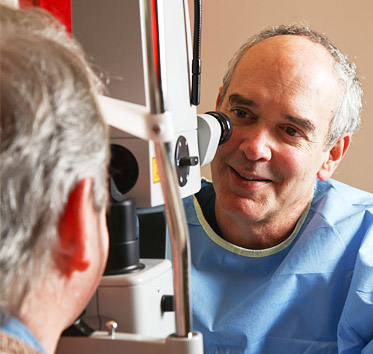Laser Surgery
Lasers are ubiquitous in our lives. We see them used in such places as the grocery store checkout stands and even in home power tools. Lasers also have many medical uses and, because of the optical clarity of the eye, the first uses of medical lasers were for eye-related conditions. Several types of lasers are used for several types of eye conditions.
Glaucoma
The tissue that drains fluid from the eye, called the trabecular meshwork, contains pigment that absorbs laser energy. The commonly done office-based procedure, laser trabeculoplasty, uses this principle and is commonly used to treat eyes with open angle glaucoma. The laser is aimed at the trabecular meshwork and, depending on the type of laser and the specific technique, the laser is applied and is absorbed by pigment which then alters the biochemistry of the cells lining the drainage channel. This improves function and usually lowers eye pressure. This is a straight-forward procedure with a large safety margin. It can be repeated if needed.
A laser treatment used in a more unusual form of glaucoma called narrow angle glaucoma is laser iridotomy. In this condition a laser, usually the YAG laser, is used to create a small opening in the iris to allow equalization of fluid pressure between the front chamber of the eye and the structures behind the iris. This usually restores a more normal anatomy to the drain of the eye and can treat or prevent total closure of the drain, a dangerous condition called acute angle closure.
Retina
The retina is the light absorbing tissue in the back of the eye. This was the first tissue to be treated medically with a laser.
Diabetes
The laser is routinely used to treat leaking or swollen retinal tissue that develops as a result of diabetic damage to the blood vessels. When the retina becomes deficient of oxygen, new blood vessels may grow which can leak and bleed. The laser is highly effective at reducing or eliminating these vessels when a procedure called panretinal photocoagulation is performed.
Macular Degeneration
Macular Degeneration is a common condition of aging that can result in blood vessels breaking through the normal retinal barriers and leaking or bleeding, a condition called choroidal neovascularization. The laser can be used to destroy these vessels.
Retinal tears
Tears in the retina can occur from a variety of conditions. If untreated they can cause bleeding or a retinal detachment. Laser treatment is used to seal the retinal tear to prevent fluid from tracking under the retina, preventing a more serious retinal detachment.
Cataract
The transparent tissues that secure the lens implant can become cloudy with time, a condition called a secondary cataract or capsular opacification. The YAG laser is used to easily and safely restore clarity to the optical system. The procedure is painless and activities can quickly be resumed.
Refractive Surgery
The eximer laser is commonly used to reshape the corneal surface. This highly accurate device effectively treats refractive errors such as myopia, farsightedness and astigmatism.
